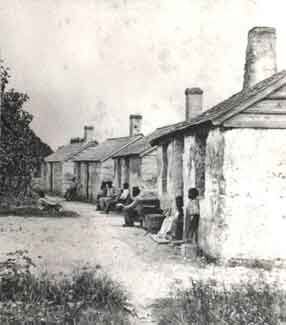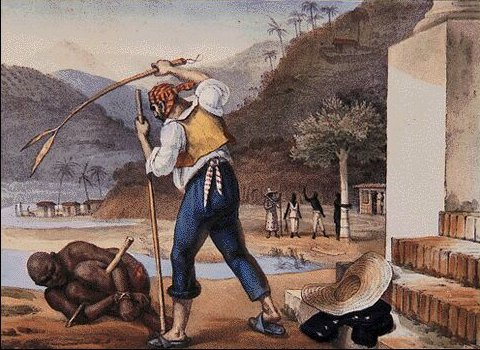The concepts covered in this fact sheet go beyond those seen in high school. It is intended as a supplement for those who are curious to learn more.
Mercantilism is an economic doctrine (belief or theory) of the 16th and 17th centuries, according to which a state's primary wealth is gold and silver.
The economic doctrine of mercantilism guided economic decisions until the 18th century. According to this doctrine, a state's power is proportional to its reserves of precious metals. A state must therefore enrich itself through foreign trade. Metropolises encouraged exports and imports with their colonial possessions. The aim was to protect and increase the country's reserves. To achieve this, they set up trading posts in their colonies. These trading posts facilitated the acquisition of goods.
In Quebec, several trading posts had been established to facilitate the fur trade. Merchants could easily exchange their goods for furs from coureurs des bois or native peoples.
After the discovery of America and the conquest of the native peoples, Europeans quickly took possession of the new territories. With these new territories, they discovered products that were still unknown to them: corn, potatoes, tomatoes, cocoa, etc. Trade was soon organized between the colonies and the countries of Europe. In addition to the new products, the colonists exported other important agricultural products such as tobacco, sugar and coffee, as well as taking advantage of the precious metals contained in American soils.
Europeans imported agricultural products from America in very large quantities. In the early years of colonization, agricultural products accounted for 20% of European imports from America. However, this proportion increased significantly over the course of the 18th century.
Little by little, Europeans incorporated these products into their diet: tomatoes, corn, potatoes and cocoa. Over time, some people even succeeded in adapting plants to the European climate. Tomatoes and potatoes now grew in European vegetable gardens. Sugar and tobacco consumption is also on the rise in Europe.
The Spanish conquistadors were quick to note the wealth of the cities of the native civilizations. This is what prompted them to explore the territory: to unearth more precious metals. The precious metals sent to Europe came from two sources: mines and spoils of war. Spoils of war came mainly from Aztec and Inca cities. When taken by the conquistadors, these cities were stripped of their wealth.
The mines of most interest to the Europeans were gold and silver. They were quick to exploit the gold mines of Cuba and the silver mines of Peru. In the 18th century, Mexican and Brazilian mines were added. The most profitable mining operation of the 18th century was undoubtedly in Mexico.
All American mines contributed more wealth than European and African mines combined. However, this mining production, while important for European countries, did not dominate the economy.
The new continent, rich in agricultural and mining products, initiated a series of changes in the organization of trade. From then on, trade took place on every continent. This became known as the world economy.
The concept of world economy refers to all the commercial exchanges that take place between all the continents of the globe.
States that manage external territories have even greater potential for enrichment, provided they are well organized. This is how we distinguish between metropolises and colonies.
Metropolises are states that manage territories outside their borders. These external territories, the colonies, are dependent on the metropolises.
Triangular trade was the solution employed by the metropolises to make travel between the various colonies and the metropolis as profitable as possible.
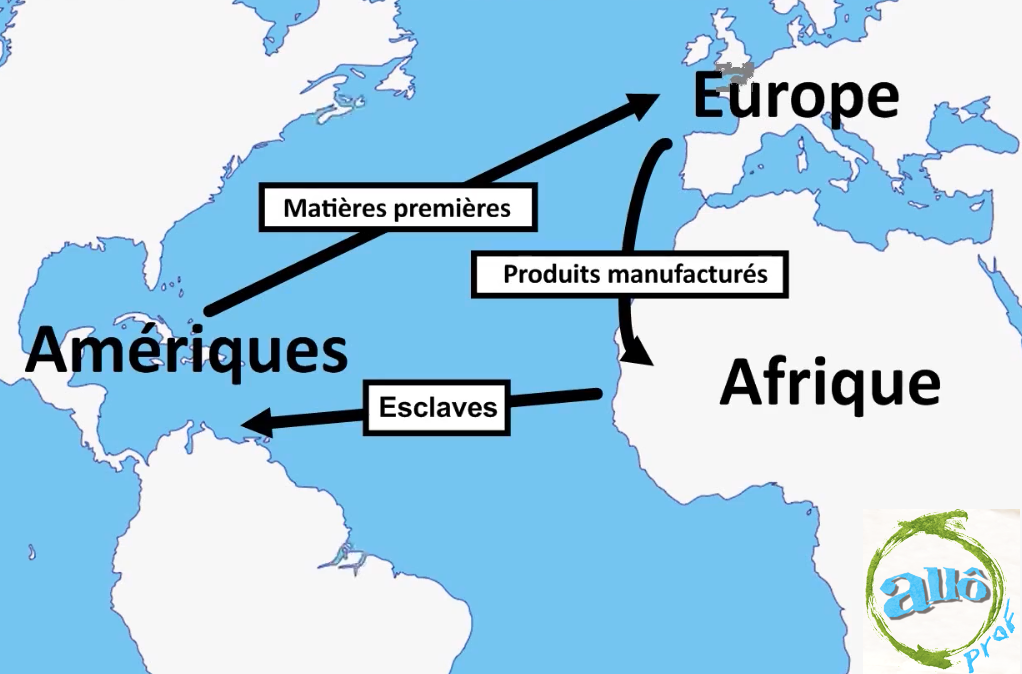
Diagram of how triangular trade works
This way of organizing world trade mainly benefited the metropolises, who could easily export and import goods between their colonies without ever having to draw on their reserves. However, the metropolises were not the only beneficiaries of this system: the merchants who managed the ships and the African kings all benefited. The merchants get a share of the wealth they travel with, while the African kings gain not only in valuables, but above all in power thanks to their weapons.
First, ships set sail from European countries. They are loaded with manufactured goods, weapons, alcohol, glassware (small glass objects), etc.
Secondly, these products arrive near the African coast. The merchants aboard the ships carry out transactions: they exchange their goods for slaves. These European merchants do business with the powerful kings of African countries, or with slave traders.
Thirdly, the ships set sail again from the African coast. This time, they are loaded with slaves and set sail for the American colonies.
Fourthly, when they arrive in America, the merchants exchange the slaves for products from the colonies (rum, sugar, tobacco, agricultural produce, precious metals).
Finally, the ships, laden with wealth from the Americas, set sail once again for Europe.
One aspect of the triangular trade involved the African slave trade. It is important here to provide some information about this aspect of colonization.
Some excerpts from the following text may shock.
Before resorting to African slaves, Spanish settlers forced native inhabitants to work in the mines and on agricultural plantations. Agricultural practices were aimed first and foremost at economic profitability. As a result, the colonists increasingly developed large sugarcane plantations, and soon needed large numbers of workers. However, the natives recruited soon died, either because they had contracted a fatal disease of European origin for which they had no antibodies, or because they succumbed to the heavy physical tasks they had to perform.
As the number of employees needed on the plantations continued to grow, the settlers had to quickly find alternatives when the natives ran out. The first solution they came up with was to hire Europeans. They were given access to the new territories on condition that they worked on the plantations for 36 months. This solution worked for a while. Soon, however, the number of volunteers dwindled. Working conditions were so poor that less than half of those hired survived the task. Eventually, this state of affairs became more widely known, and would-be immigrants were no longer willing to sign contracts that might lead them to their deaths. By 1720, no one was volunteering.
From 1502, the colonists supplemented the workforce with Africans from Spanish plantations and Arab slave markets. By this time, all workers had the same working conditions, whether black or white. However, the proportion of Africans was still rising. Workers were increasingly recruited under duress and by force. The first African indentured laborers in North America arrived in Virginia in 1619.
By the end of the 17th century, African slave laborers outnumbered white settlers. That's why the colonists began to draw up laws governing slave conditions. They wanted to avoid revolts or racial mixing. At the time, the English relied on their interpretation of the Bible to justify the status and treatment of slaves.
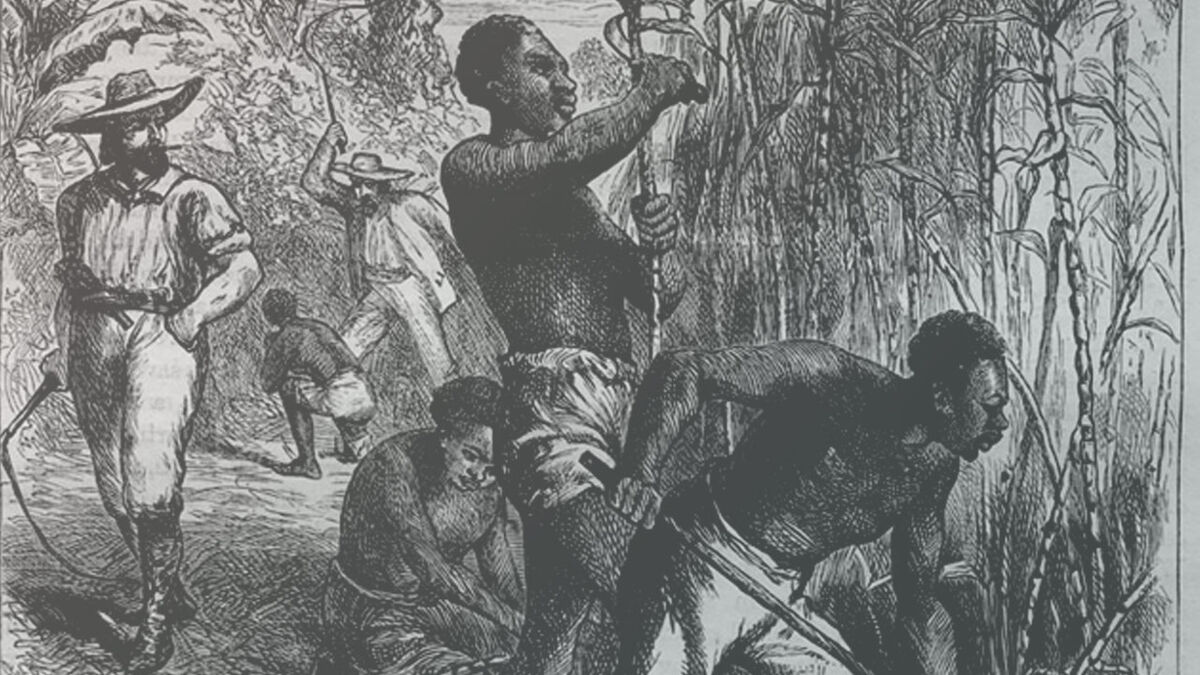
Slaves at work on a sugar plantation
Merchant ships used to transport slaves are called slave ships. These ships were designed to easily transport both goods and groups of slaves. Ships from Europe made their first stop on the African coast. Here, merchants exchanged goods for strong, healthy slaves. Around 600 slaves were branded and chained in the holds of the ships. There they were crammed together, with no bed, no water, no toilet and no real possibility of movement. The Atlantic crossing could last between 3 and 6 weeks, during which both slaves and crew members succumbed to the harsh, unhygienic living conditions. The mortality rate among slaves was around 10% to 20%.
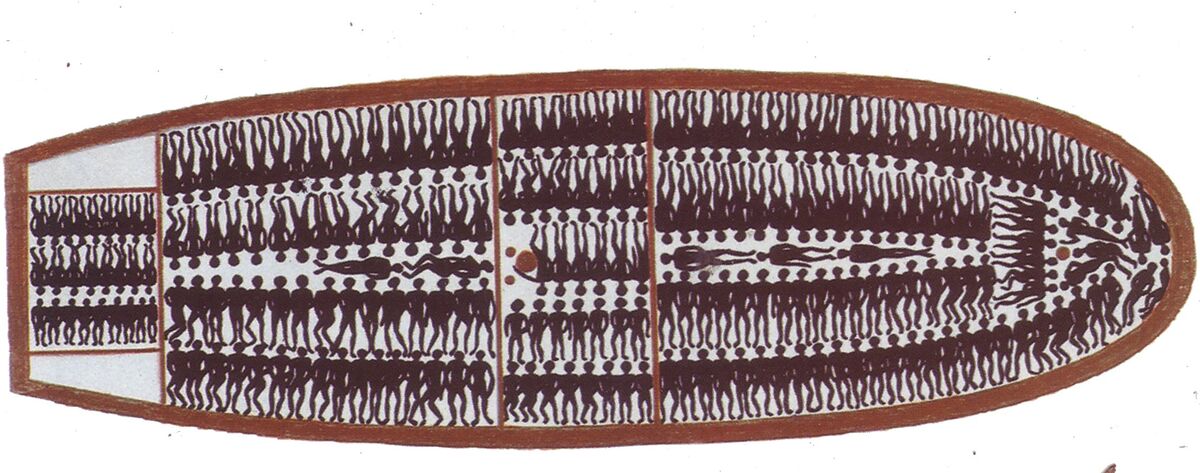
General view of a ship carrying slaves from Africa
The transportation of African slaves to America began as early as the 16th century and continued until the 19th century. In the 18th century alone, historians have estimated the number of Africans transported to America at around 7.5 million. For the entire period of the slave trade, over 12 million Africans were sold to Europeans by African kings and Arab merchants. The countries that bought the most slaves were Portugal, Great Britain, Spain and France. The Netherlands and the United States also feature in this sad list.
The slave trade to the Americas was not the only trade of this kind. Between the 8th and 19th centuries, no fewer than 17 million slaves were shipped to the Middle East, North Africa and the Indian Ocean.
Slave masters never really treated them with pity or compassion. These feelings were deemed unnecessary, since slaves were simply not considered human. For plantation owners, slaves were just another commodity to be kept in stock and expected to perform well.
From the moment they were selected aboard ship, families could be separated at any time. The plantation masters would select the best and brightest, without ever taking into account the ties between parents and children. Slaves lived on their masters' land, in small houses with no furniture, using the floor as a bed. Hygienic conditions were poor, and many slaves suffered from infectious diseases.
Slaves were forced to work long hours on the plantations. The work is hard and trying for everyone: men, women, pregnant women and children as young as 10. To meet their dietary needs, they are allowed only a poor diet: bananas, rice and yams (a root vegetable resembling the potato). They eat practically no meat. This diet was woefully inadequate for the heavy tasks they had to perform. Slaves are allowed only one day off per week. To clothe themselves, they receive new clothes and two pairs of shoes that must last a whole year.
On the plantations, a steward was in charge of controlling the slaves' work. He represents the authority and is therefore able to punish his slaves as he sees fit. For their part, the slave masters have all the rights. They decide on education, religion and work. In some cases, slaves were forbidden to talk about their country of origin. Generally speaking, masters preferred not to educate their slaves, since they believed that an educated slave was a dangerous slave.
The masters did, however, teach them religion, so that they would be good Christians. The slaves learned nothing about heaven or divine grace. According to the masters, these teachings were useless since the slaves would not have access to them.
Owners also enjoyed full rights of punishment and physical abuse. The only limitation was that they had to keep the “merchandise” in working order. Since slaves were seen only as working tools, masters had to punish them for unsatisfactory work, while ensuring that they retained the valuable capital they represented. Sometimes, masters reserved the right to punish slaves to the point of death. This was the punishment meted out when a slave hit his master.
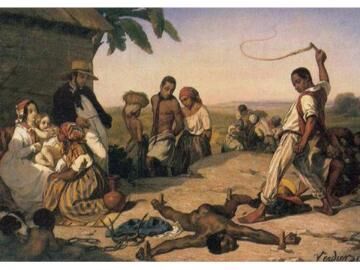
Bodily harm inflicted on a slave
When the slave trade began, it was seen as the easy way to increase the wealth of the metropolises. The enslavement of Natives and Blacks represented the thinking of the time. Hardly anyone questioned the practice of slavery, not even philosophers.
However, some kings, including King Louis XIV, saw fit to create legislation on slavery, but the aim was not to ban it. In those days, it would have been impossible to do so without alienating all the rich, merchants and royalty. The first law on slavery was French, drafted by Colbert, a minister of Louis XIV. This law stipulated that slaves were chattels to be educated in the Christian faith.
The Black Code was drawn up in the 17th century to clearly establish the legal status of slaves. Far from defending the slave's own identity, this code established his status as a commodity who owed obedience to his master. The text was long used to defend and justify the abuses inflicted on slaves, and to criminalize their freedom.
Slavery enriched plantation owners until the 19th century, when the slave trade was officially abolished. Throughout these years, however, slavery practices held back technical development. Indeed, since the masters benefited from a virtually unlimited labor force, they didn't necessarily look for ways to make harvests more profitable by providing less work. Despite the lessons of history, slavery is still practiced in some countries today.
